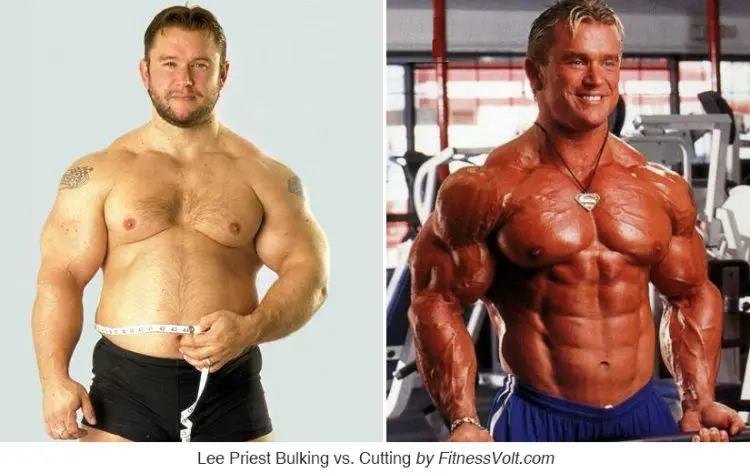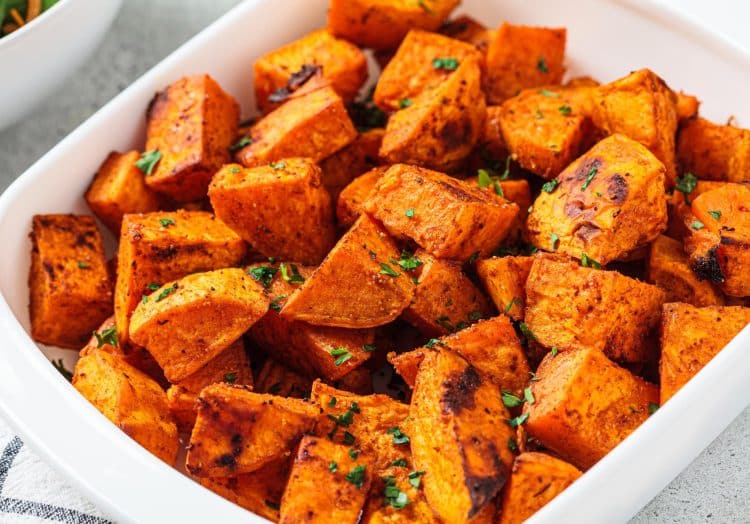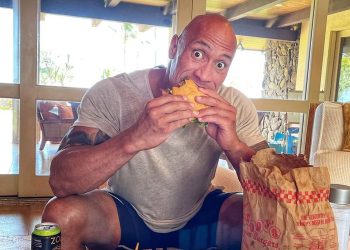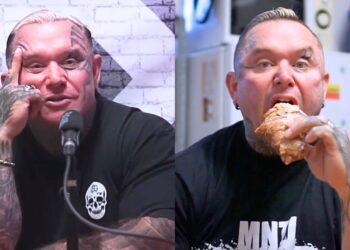Bulking is one of the most popular ways to build muscle and gain body weight, especially amongst bodybuilders.
During a bulk, you train hard and heavy while in a significant calorie surplus. Eat big to get big, bro! All those extra calories fuel your muscle-building workouts and give your body the energy it needs to recover and grow, you can read more about bulking here.
As well as being an effective way to gain muscle, bulking is usually a lot of fun. That’s because you get to eat a lot more than usual and will probably feel stronger and more energetic, too. Your weight should increase more or less weekly, and your muscles will quickly start to fill out and look bigger.
Unfortunately, bulking has a downside – a lot of the weight you gain will be fat.
That extra body fat will obscure your muscle definition and separation, leaving you looking more like a hefty powerlifter and less like a shredded bodybuilder. You may even become dangerously overweight if you bulk for too long.
That’s why most lifters follow a bulking/cutting cycle. They gain muscle and fat during the bulk, and then diet (or cut) the fat away.
Level Up Your Fitness: Join our 💪 strong community in Fitness Volt Newsletter. Get daily inspiration, expert-backed workouts, nutrition tips, the latest in strength sports, and the support you need to reach your goals. Subscribe for free!
However, as well as losing fat, you’ll probably still lose some hard-won muscle during your cut. And, let’s be honest here, cutting diets are no one’s idea of fun. Losing a lot of fat requires a strict nutrition plan, plenty of clean eating, and training while you’re in a calorie deficit, which can be exhausting.
And then there’s the cardio…so much cardio!
The good news is that there is an alternative to traditional bulking and cutting – lean bulking. With lean bulking, you gain weight more slowly, but almost all of that weight is muscle.
In this article, we reveal how to do a lean bulk and the macros you should use for the best results.
What is a Lean Bulk?
A lean bulk is a dietary and training program designed to increase muscle mass while minimizing fat gain. It’s the ideal approach for natural lifters, non-competitive bodybuilders, and anyone who doesn’t want to gain lots of body fat while building muscle.
However, to understand how lean bulking works, you first need to understand how it differs to the traditional approach to bulking.
Traditional vs. Lean Bulking
During a traditional bulk, you increase your food intake to create a large calorie surplus. This is typically 500-1500 calories above maintenance. While such a large surplus virtually guarantees weight and muscle gain, much of that weight will be body fat.
How much fat you gain during a bulk will depend on the size of your calorie surplus, how long you bulk for, and your genetic propensity for storing body fat. That said, you should expect to gain a fair amount of body fat alongside your increased muscle mass.
With a lean bulk, you still increase your calorie intake, but the surplus is far smaller. The aim is to provide your body with the calories you need to train and grow, but without the excess that would otherwise lead to fat gain.
You may still gain a little body fat during a lean bulk, but it will be nowhere near as much as you get during a traditional bulk.
Because of this, lean bulking is suitable for long-term use. In fact, if your body fat percentage is already relatively low, you can lean bulk pretty much forever. This is definitely NOT the case with traditional bulking, and following a bulking plan for too long, i.e., perma-bulking, can lead to becoming overweight.
Best of all, with lean bulking you won’t have to go on a strict cutting diet to rid your body of any unwanted fat. If you DO need to shed a few pounds and get ripped, e.g., for a beach vacation or photoshoot, a couple of weeks of dieting should be all you need to get into peak condition.
Lean Bulk Drawbacks
If lean bulking has a downside, it is that your progress will be much slower than for a traditional bulk.
During a traditional bulk, your weight will probably increase from one week to the next. You may gain as much as 1-2 pounds per week. You’ll also get noticeably stronger. This rapid, measurable progress is very motivating.
In contrast, lean bulk progress is usually much slower and may not be as obvious. You may even feel that your progress has stalled. However, as the weeks turn into months, you should start to see changes in your physique as you gain muscle without fat.
Successful lean bulking requires patience, and you’ll need to stay motivated despite not seeing rapid results. However, it’s arguably the best way to build muscle while maintaining a lean physique.
How to Calculate your Calories for Lean Bulking
You don’t really have to count calories during a traditional bulk; you just need to eat more than usual. This can take the form of an extra meal per day, more snacks, a weight gain shake, or simply increasing the size of your breakfast, lunch, and dinner.
When deciding how much to eat during a traditional bulk, the answer is usually “more!”
In contrast, you need to control your calorie intake far more precisely during a lean bulk. Eat too much, and you’ll soon start gaining unwanted body fat.
For a successful lean bulk, you need to increase your caloric intake to around 200-300 calories above maintenance. This small surplus should be just enough to fuel muscle growth while minimizing fat gain.
The most straightforward way to determine your lean bulk calorie intake is to use an online TDEE calculator. Your TDEE (Total Daily Energy Expenditure) is the number of calories you need to eat to maintain your current weight.
Then, once you know your TDEE, add 200-300 to that number to determine how many calories you need to eat per day to build muscle without gaining fat.
Armed with your lean bulk daily calorie requirements, you then need to start analyzing your food intake and counting calories to ensure you consume the right amount of food. Use a meal-tracking app to make this as easy as possible.
Lean Bulk Macros
While calories matter during a lean bulk, the source of those calories is also important. We get calories from our dietary macronutrients or macros for short.
The three macronutrient groups are:
- Protein – essential for muscle recovery, repair, and growth
- Carbohydrates – your body’s primary source of energy during high-intensity exercise
- Fat – a valuable source of energy and required for health and hormonal balance
The right mix of macros, known as your macro ratio, will provide your body with the fuel it needs to grow while minimizing fat storage. For example, you need sufficient protein for muscle repair but should avoid consuming too much carbohydrate or fat as both can lead to weight gain.
You can use a macro calculator to determine your protein, carbohydrate, and fat needs or, alternatively, adopt one of these tried and tested lean bulk macro ratios:
- Protein 30%
- Fat 30%
- Carbohydrates 40%
Or:
- Carbohydrates 50%
- Protein 30%
- Fat 20%
Or:
- Carbohydrates 40%
- Protein 25%
- Fat 35%
Finally, you could simply adjust your macros based on your calorie intake and forget about the actual ratios:
- Protein: 2-2.5 grams per kilogram (2.2 pounds) of bodyweight
- Carbohydrates: 4-7 grams per kilogram of bodyweight
- Fat: 0.5-2.0 grams per kilogram of bodyweight
Which lean bulk macro ratio is best?
In general, the more active you are, the more carbs you can tolerate without gaining fat. Naturally lean people usually do well on higher-carb diets. In contrast, if you tend to gain fat easily or have a more sedentary lifestyle, you will probably do better using a ratio that emphasizes protein.
Another thing to consider is the types of food you enjoy. Some people prefer higher-carb diets and like eating foods like pasta, bread, and potatoes. Others feel better on a higher-fat diet and find that carbs make them feel bloated or sluggish.
Whatever lean bulk macro ratio you pick, it’s crucial to stick with it for 4-6 weeks to determine its effectiveness. Then, if you are not getting the desired results, or feel another macro ratio might suit you better, you can switch to a different one.
The Best Lean Bulk Foods
It’s beyond the scope of this article to tell you what to eat on your lean bulk. After all, your meals will depend on your preferred macro ratio, your grocery budget, your cooking ability, the foods you enjoy, and a host of other details we have no way of knowing.
That said, we CAN give you a good idea of the types of food you should include in your lean bulk diet and what you should avoid.
Lean Bulk Protein Sources
Whatever lean bulk macros ratio you choose, protein is probably the most important food group. After all, it’s protein that provides your body with amino acids, which are essential for muscle repair, recovery, and growth.
Level Up Your Fitness: Join our 💪 strong community in Fitness Volt Newsletter. Get daily inspiration, expert-backed workouts, nutrition tips, the latest in strength sports, and the support you need to reach your goals. Subscribe for free!
Good lean bulking protein foods include:
- Beans
- Beef
- Chicken
- Cottage cheese
- Eggs
- Fish
- Lentils
- Low-fat milk
- Natural yogurt
- Protein powder
- Seitan
- Soy
- Tempah
- Turkey
Related: Our List of 40 Great Protein-Packed Foods
Lean Bulk Carbohydrate Sources
Carbohydrates are your primary sources of energy, vitamins, minerals, and fiber. However, there are good lean bulking carbs, and carbs that are more likely to lead to fat gain.
Good carb sources include:
- All fruits, especially low-sugar fruits and berries
- All vegetables, especially leafy green and cruciferous veggies
- Oats
- Quinoa
- Rice, including white, brown, and wild varieties
- Spelt
- Sprouted grains
- Sweet potatoes
- White potatoes
- Whole grain pasta
- Wholemeal bread
Lean Bulk Fat Sources
Somewhat counterintuitively, you need to eat fat to lose fat and build muscle. Your body uses fats to control inflammation, synthesize steroid hormones, and for immunity and joint health. However, they’re also very high in calories, so you should choose your fat sources wisely.
Good lean gain fat sources include:
- Avocados
- Coconut oil
- Egg yolks
- Extra-virgin olive oil
- Nuts and seeds
- Peanut and almond butter
Build most of your meals around these foods, and you should have no problem creating a lean bulk diet that’s both effective and enjoyable. However, make sure that, at the end of each day, you hit your calorie and macro goals. Ultimately, that’s more important than what you actually eat.
Foods to Avoid During a Lean Bulk
Because you need to control your calorie intake while hitting your macro goals, there isn’t much space in a lean bulk diet for lots of empty calories and junk food. To that end, it’s generally best to minimize your intake or avoid completely the following types of food:
- Alcohol
- Baked goods
- Breakfast cereals
- Candy
- Chocolate
- Deep-fried food
- Desserts e.g., pudding, ice cream, etc.
- French fries
- Pizza
- Potato chips
- Processed meals
- Soda (diet soda is okay in moderate amounts)
- Sweets
- Takeouts
While this list is far from exhaustive, it should give you an idea of the sorts of food that don’t really fit with the lean bulking philosophy.
So, when confronted with a food you want to eat, stop and ask yourself “will this help or hinder my progress?” If the answer is hinder, you should skip that food and eat something else.
Lean Bulk Macro FAQs
Do you have a question about lean bulk macros and dieting? Don’t worry – we’ve got the answers!
1. What is the best lean bulking diet?
Unfortunately, there is no one-size-fits-all best lean bulking diet. After all, we all have different food preferences, grocery budgets, and cooking facilities/abilities. What works well for one person may be completely unsuitable for someone else.
So, the best lean bulking diet is the one that you can stick to. Because of this, you should use the calorie and lean bulk macro guidelines in this article and create your own diet.
And remember, lean bulking is a slow process, but that’s the price you have to pay for gaining muscle and not fat. So, create a diet you can maintain for as long as it takes to reach your body composition goal.
2. What workout is best when lean bulking?
The main objective of lean bulking is to build muscle. Therefore, you should adopt a bodybuilding approach to your workouts. You can do almost any hypertrophy-type training program during a lean bulk, including:
However, because your calorie surplus is relatively small, avoid high-volume training programs, as you won’t be eating enough to recover from that kind of workout.
3. How much cardio should I do during a lean bulk?
If you’ve got your calories and macros right, you shouldn’t need to do a lot of cardio to stay lean and avoid fat gain. If you feel like you need to do more cardio, your calorie surplus may be too high.
That said, if you enjoy cardio, feel free to include it in your lean bulk workout plan. After all, it’s good for your health – both mental and physical.
However, remember that cardio uses energy, and it could be eating into your already small calorie surplus. Make sure you consider this extra activity when determining your calorie surplus. You may need to eat more if you do a lot of cardio, otherwise your surplus may be wiped out.
4. Which supplements should I use during a lean bulk?
While you don’t have to use supplements for a successful lean bulk, they are sometimes helpful. Some are designed to speed up recovery, while others allow you to train a little longer and harder.
Useful supplements during a lean bulk include:
- Amino acids – to enhance recovery
- Creatine monohydrate – for muscle growth and recovery
- Pre-workout – for a quick energy boost
- Protein powder – to make it easier to get enough daily protein
- ZMA – for better sleep and anabolic hormone production
However, remember even the best supplement will not help you if your diet isn’t dialed in and you aren’t training hard and consistently. Think of supplements as effort multipliers; the harder YOU work, the more THEY work.
5. How can I tell if my lean bulk is working?
Because progress is slow on a lean bulk, it can be hard to tell if your workouts and diet are having the desired effect. Your weight probably won’t change much from one week to the next, and you might not feel stronger or look bigger.
However, little by little, your body WILL change, and you’ll gradually increase muscle size without gaining fat. But, these changes may be so slow that you don’t see them.
The best ways to monitor your progress are:
- Body composition assessments, e.g., skinfold measurements, DEXA scans, or bioelectrical impendence testing
- Girth measurements, e.g., waist, chest, upper arms, thighs
- Full-body progress photos…
Because your progress will be gradual, you should NOT perform these assessments too often. Instead, do them monthly to see how your lean bulk is going.
6. How long does a lean bulk take?
Unfortunately, it’s impossible to say how long a lean bulk will take as we don’t know your current condition or ultimate body composition goal. It could take you a few months or a couple of years to reach your target.
Don’t put a deadline to your lean bulk, as it’s impossible to say how long it’ll take you to gain the amount of muscle you want. Instead, accept lean bulking as a way of life for the foreseeable future, and stick with it until you are satisfied with your results.
7. Can I have cheat meals on a lean bulk?
You can have a cheat meal on any kind of diet, including a lean bulk. However, you must understand that every cheat meal has the potential to disrupt or delay your progress. For example, if you go overboard, your cheat meals could lead to unwanted fat gain, making your lean bulk more like a traditional bulk.
Still, a weekly or bimonthly cheat meal probably won’t harm your progress, so feel free to relax your diet now and then. However, don’t eat so much that you undo all your good work.
Read also: Use these guidelines to ensure your cheat meal doesn’t wreck your clean bulk diet.
8. Is lean bulking safe?
Lean bulking is a very safe approach to dieting and weight management. Unlike traditional bulking diets, you don’t have to force feed yourself, nor will you gain excess body fat. Providing you avoid dirty lean bulking (see question #10) and don’t have too many cheat meals, lean bulking should enhance your health as well improve your appearance.
9. How often do I need to recalculate my lean bulk calories and macros?
As you gain muscle, your need for calories and macros increases. However, because your progress will be slow, you won’t need to recalculate your nutritional needs very often. Instead, it should be enough to revise your macros and calories every 6-8 weeks. That said, if your progress stalls, you may need to do it sooner.
For example, suppose you feel like you are gaining fat. In that case, you are probably consuming too many calories. You should reduce your daily surplus to avoid making things worse.
Conversely, if you don’t think you are gaining muscle, you may need to up your calorie intake by another 100-200 per day.
10. Can I do a dirty lean bulk?
Dirty bulking refers to the idea that calories and macros matter more than food quality. In short, with dirty bulking, you can eat whatever you want provided it meets your daily energy and macro needs. And yes, that includes junk food.
While you could try this approach with a lean bulk, it’s probably impractical. Most so-called dirty foods are high in calories, aren’t very filling, and are usually unhealthy. As such, you won’t be able to eat as much and will probably be hungry much of the time.
So, in theory, a dirty lean bulk COULD work, the odds are stacked against you, and you’ll probably get better results from a cleaner approach to nutrition.
Read also: You can read more about dirty bulking vs. clean bulking here.
Lean Bulk Macros – Wrapping Up
While there is nothing inherently wrong with traditional bulking and cutting cycles, they’re not the only way to build muscle and get lean. In fact, for most gym rats, bulking and cutting may be unnecessary, impractical, and quite possibly unhealthy.
While it will take longer to build muscle, lean bulking minimizes unwanted fat gain, and saves you from having to diet off excess weight. In addition, wherever you are on your lean bulk, you’ll always be in pretty good shape, even if you aren’t as muscular as you want to be – yet!
Lean bulking does require patience, and you’ll need to take a more structured approach to your diet. However, if you want to want to build muscle without getting fat, lean bulking is the way to do it.














